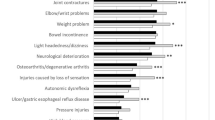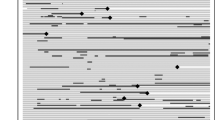Abstract
Study design:
Single-blind randomized controlled trial of 6 months’ duration.
Objectives:
To evaluate the efficacy of a novel telehealth intervention, ‘CareCall’, on reducing pressure ulcers and depression and enhancing the use of appropriate health care.
Setting:
General community, Massachusetts and Connecticut, United States
Methods:
‘CareCall’ is an automated, interactive voice response system that combines patient education, cognitive behavioral interventions, screening and referrals, with alerts to a nurse telerehabilitation coordinator for direct non-emergent phone follow up. Participants consisted of a convenience sample of 142 persons with multiple sclerosis or spinal cord injury using a wheelchair >6 h per day. The intervention group received CareCall (n=71) The control group received usual care (n=71). The main outcome measures were: The pressure ulcer scale for healing tool, Patient Health Questionnaire—9 depression scale, Cornell Services Index and Craig Hospital Inventory of Environmental Factors-Short Form Question 5.
Results:
CareCall achieved a reduction in presence of pressure ulcers at 6 months in women (P<0.0001). Among those with baseline depression, CareCall reduced 6-month severity of depression, adjusting for age and gender (P<0.047). CareCall did not have a significant impact on health-care utilization (OR=1.8, P=0.07), but did significantly improve participants’ report of health-care availability (OR=2.03, P<0.04).
Conclusion:
This is the first study to demonstrate the efficacy of a largely automated telehealth intervention for adults with spinal cord dysfunction. Future research needs to replicate this study in a larger, multisite trial.
Similar content being viewed by others
Log in or create a free account to read this content
Gain free access to this article, as well as selected content from this journal and more on nature.com
or
References
Chen Y, DeVivo MJ, Jackson AB . Pressure ulcer prevalence in people with spinal cord injury: age-period-duration effects. Arch Phys Med Rehabil 2005; 86: 1208–1213.
Redelings MD, Lee NE, Sorvillo F . Pressure ulcers: more lethal than we thought? Adv Skin Wound Care 2005; 18: 367–372.
Hoffman JM, Bombardier CH, Graves DE, Kalpakjian CZ, Krause JS . A longitudinal study of depression from 1 to 5 years after spinal cord injury. Arch Phys Med Rehabil 2011; 92: 411–418.
Dalton EJ, Heinrichs RW . Depression in multiple sclerosis: a quantitative review of the evidence. Neuropsychology 2005; 19: 152–158.
Regan M, Teasell RW, Keast D, Aubut JL, Foulon BL, Mehta S . Pressure Ulcers Following Spinal Cord Injury. In: Eng JJ, Teasell RW, Miller WC, Wolfe DL, Townson AF, Hsieh JTC, et al (eds). Spinal Cord Injury Rehabilitation Evidence (SCIRE), Version 4.0 (http://www.scireproject.com/rehabilitation-evidence/pressure-ulcers/prevention/pressure-ulcer-prevention-education-post-sci).
Mohr DC, Hart S, Vella L . Reduction in disability in a randomized controlled trial of telephone-administered cognitive-behavioral therapy. Health Psychol 2007; 26: 554–563.
Bombardier CH, Cunniffe M, Wadhwani R, Gibbons LE, Blake KD, Kraft GH . The efficacy of telephone counseling for health promotion in people with multiple sclerosis: a randomized controlled trial. Arch Phys Med Rehabil 2008; 89: 1849–1856.
Kaplan B, Farzanfar R, Friedman RH . Personal relationships with an intelligent interactive telephone health behavior advisor system: a multimethod study using surveys and ethnographic interviews. Int J Med Inform 2003; 71: 33–41.
Dallolio L, Menarini M, China S, Ventura M, Stainthorpe A, Soopramanien A et al. Functional and clinical outcomes of telemedicine in patients with spinal cord injury. Arch Phys Med Rehabil 2008; 89: 2332–2341.
Houlihan BV, Jette A, Paasche-Orlow M, Wierbicky J, Ducharme S, Zazula J et al. A telerehabilitation intervention for persons with spinal cord dysfunction. Am J Phys Med Rehabil 2011; 90: 756–764.
Stotts NA, Rodeheaver GT, Thomas DR, Frantz RA, Bartolucci AA, Sussman C et al. An instrument to measure healing in pressure ulcers: development and validation of the pressure ulcer scale for healing (PUSH). J Gerontol A Biol Sci Med Sci 2001; 56: M795–M799.
Kroenke K, Spitzer RL, Williams JB . The PHQ-9: validity of a brief depression severity measure. J Gen Intern Med 2001; 16: 606–613.
Sirey JA, Meyers BS, Teresi JA, Bruce ML, Ramirez M, Raue PJ et al. The Cornell Service Index as a measure of health service use. Psychiatr Serv 2005; 56: 1564–1569.
Whiteneck GG, Harrison-Felix CL, Mellick DC, Brooks CA, Charlifue SB, Gerhart KA . Quantifying environmental factors: a measure of physical, attitudinal, service, productivity, and policy barriers. Arch Phys Med Rehabil 2004; 85: 1324–1335.
Prochaska JO, Velicer WF . The transtheoretical model of health behavior change. Am J Health Promot 1997; 12: 38–48.
Bandura A . Health promotion by social cognitive means. Health Educ Behav 2004; 31: 143–164.
Hedges LV, Olkin I (eds). Statistical Methods for Meta-Analysis. Academic Press: Orlando, FL, USA. 1985.
Bloemen-Vrencken JH, de Witte LP, Post MW . Follow-up care for persons with spinal cord injury living in the community: a systematic review of interventions and their evaluation. Spinal Cord 2005; 43: 462–475.
Kairy D, Lehoux P, Vincent C, Visintin M . A systematic review of clinical outcomes, clinical process, healthcare utilization and costs associated with telerehabilitation. Disabil Rehabil 2009; 31: 427–447.
Glanz K, Shigaki D, Farzanfar R, Pinto B, Kaplan B, Friedman RH . Participant reactions to a computerized telephone system for nutrition and exercise counseling. Patient Educ Couns 2003; 49: 157–163.
Farzanfar R, Locke SE, Heeren TC, Stevens A, Vachon L, Thi Nguyen MK et al. Workplace telecommunications technology to identify mental health disorders and facilitate self-help or professional referrals. Am J Health Promot 2011; 25: 207–216.
Xu C, Jackson M, Scuffham PA, Wootton R, Simpson P, Whitty J et al. A randomized controlled trial of an interactive voice response telephone system and specialist nurse support for childhood asthma management. J Asthma 2010; 47: 768–773.
Acknowledgements
We thank Diana Pernigotti from the Gaylord Hospital in Wallingford, CT, for her enthusiastic commitment to the successful implementation of this project throughout New England; and Andrew Rossi from the Medical Information Systems Unit at Boston Medical Center for providing ongoing, reliable technical assistance. This project was made possible by funding from the Centers for Disease Control and Prevention, Grant no. 5R01DD000155, the Department of Health and Human Services; and the National Institute of Disability and Rehabilitation Research, Grant nos. H133N060024, H133N110019, and H133N120002, the Department of Education.
Author information
Authors and Affiliations
Corresponding author
Ethics declarations
Competing interests
Dr Friedman’s work has been funded by the National Institute of Disability and Rehabilitation Research (NIDRR). Dr Friedman has stock ownership and a consulting agreement with Infomedics, the company that owns commercial rights to the TLC technology used in the computerized intervention. He is also a member of its Board of Directors. The remaining authors declare no conflict of interest.
Rights and permissions
About this article
Cite this article
Houlihan, B., Jette, A., Friedman, R. et al. A pilot study of a telehealth intervention for persons with spinal cord dysfunction. Spinal Cord 51, 715–720 (2013). https://doi.org/10.1038/sc.2013.45
Received:
Revised:
Accepted:
Published:
Issue date:
DOI: https://doi.org/10.1038/sc.2013.45
Keywords
This article is cited by
-
Barriers and facilitators to changing bowel care practices after spinal cord injury: a Theoretical Domains Framework approach
Spinal Cord (2022)
-
Self-management interventions for skin care in people with a spinal cord injury: part 2—a systematic review of use of theory and quality of intervention reporting
Spinal Cord (2018)
-
A feasibility pilot using telehealth videoconference monitoring of home-based NMES resistance training in persons with spinal cord injury
Spinal Cord Series and Cases (2017)
-
A Systematic Review of Telerehabilitation and mHealth Interventions for Spinal Cord Injury
Current Physical Medicine and Rehabilitation Reports (2016)
-
The delivery of specialist spinal cord injury services in Queensland and the potential for telehealth
BMC Health Services Research (2015)



